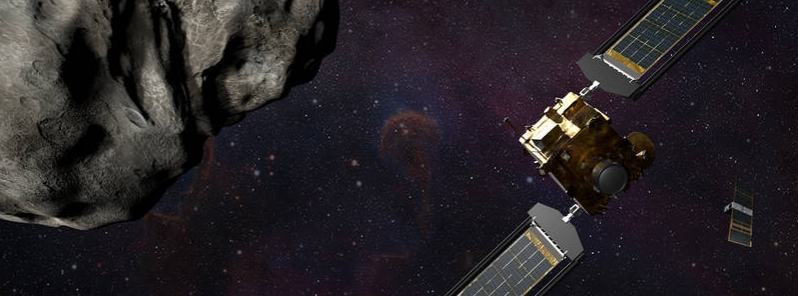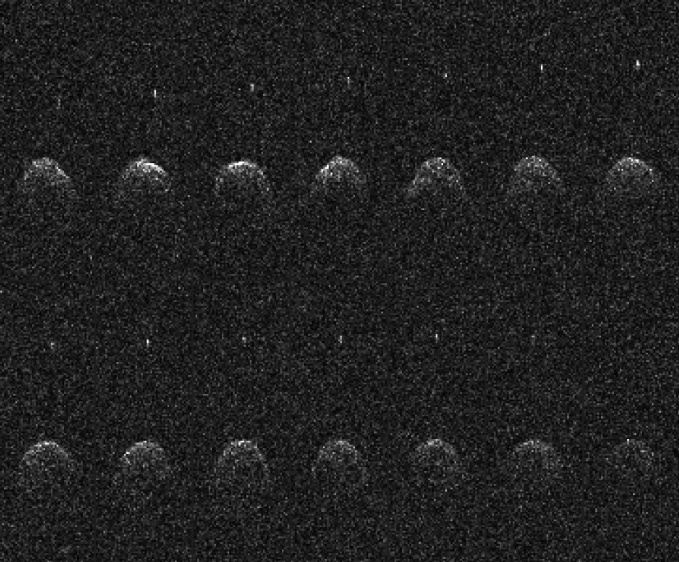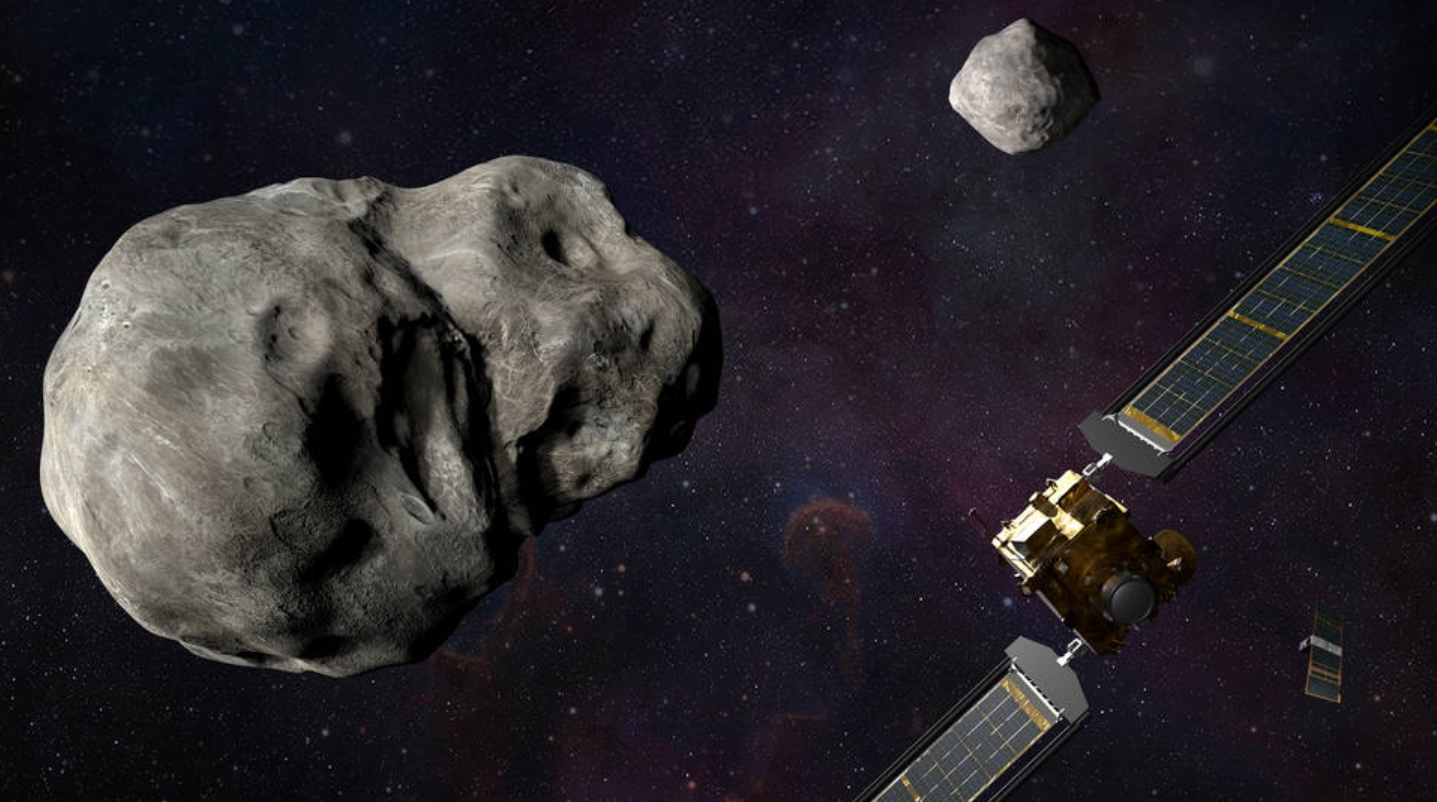NASA’s DART mission may cause first ever man-made meteor shower

The impact of NASA's Double Asteroid Redirection Test (DART) mission– which aims to nudge the orbit of its target for planetary defense purposes– may produce the first meteor shower from human activities in space, according to research published in The Planetary Science Journal. Observing the shower could allow scientists to study the composition of near-Earth objects.
The DART mission is a planetary defense-driven test of technologies made to prevent an impact by a dangerous asteroid heading to the Earth. DART will be the first demonstration of the kinetic impactor technique to alter the motion of an asteroid in space.
The target for the DART demonstration will be the binary, near-Earth asteroid named 65803 Didymos– a loose description of the larger main body and the smaller orbiting moon, Dimorphos.
Didymos primary body is approximately 780 m (2 559 feet) in diameter and its secondary body (or 'moonlet') about 160 m (524 feet), which is more typical of the size of asteroids that could pose the most likely significant threat to Earth. The two are separated by 1.18 km (0.73 miles). The primary body rotates once every 2.26 hours while the tidally locked moonlet revolves about the primary once every 11.9 hours.

14 sequential Arecibo radar images of Didymos and its moonlet, taken on November 23, 24 and 26, 2003. NASA’s planetary radar capabilities enable scientists to resolve shape, concavities, and possible large boulders on the surfaces of these small worlds. Photometric lightcurve data indicated that Didymos is a binary system, and radar imagery distinctly shows the secondary body.
According to NASA, the spacecraft will achieve the kinetic impact deflection by crashing itself into the moonlet at a speed of about 6.6 km/s (4.1 mps), with the help of an onboard camera called DRACO and sophisticated autonomous navigation software.
NASA further explained, "The collision will change the speed of the moonlet in its orbit around the main body by a fraction of one percent, but this will change the orbital period of the moonlet by several minutes – enough to be observed and measured using telescopes on Earth."
"Once launched, DART will deploy Roll-Out Solar Arrays (ROSA) to provide the solar power needed for DART’s electric propulsion system. The DART spacecraft will demonstrate the NASA Evolutionary Xenon Thruster – Commercial (NEXT-C) solar electric propulsion system as part of its in-space propulsion."
The DART spacecraft launch window will begin in late July 2021. After over a year of the cruise, it will intercept Didymos' moonlet in late September 2022, within 11 million km (6.8 million mi) from Earth.
Tom Statler, the mission's program scientist, said astronomers will be able to compare observations from Earth telescopes before and after DART's impact, to identify how much the orbital period of Dimorphos changed.
"That’s the key measurement that will tell us how the asteroid responded to our deflection effort."

Illustration of NASA’s DART spacecraft and the Italian Space Agency’s (ASI) LICIACube prior to impact at the Didymos binary system. Image credit: NASA/Johns Hopkins APL/Steve Gribben
According to the paper, the impact on that asteroid could result in the first artificial meteor shower, which will produce a minuscule amount of peril for orbiting satellites if the space rocks reach our planet.
Although the risk is small, the author said anticipating the effects could set a template for future space missions, to lessen their impacts on Earth and the commons of space through which it travels.
"There’s a fair amount of material that will be ejected," said author Paul Wiegert, an astronomy professor at the University of Western Ontario.
Most of the wreckage should be ejected at less than around 3 220 km/h (2 000 mph) and will follow the orbit of the asteroid, with no possibilities of reaching Earth for thousands of years.
If some of the debris reaches more than about 20 900 km/h (13 000 mph), which will depend on the structure of the asteroid and the angle, it could make the relatively short jump to Earth in as little as 15 to 30 days.
Wiegert added that the amount of material that could reach Earth may be about a few grams, resulting in up to 10 meteors visible in the night sky over a few days.
Aaron Boley, a planetary astronomer at the University of British Columbia, noted that this could be the first time a man-made activity on an asteroid ejects debris that reaches the planet.
"Space is big, but what we do in space can affect us."
With this, Boley suggested that changes to the DART mission could prevent debris from reaching the Earth in that 15 to 30-day timeframe.
Meanwhile, Wiegert's calculations indicate that if the impact occurs outside of a window one week before or after the asteroid's nearest approach with Earth, no material will reach the planet's path this fast.
While DART poses no significant risk, Wiegert said future asteroid missions should take this issue into account. "It’s the first of a possibly large number of meteoroid streams we might create in the solar system that could become a hazard."
Reference
"On the Delivery of DART-ejected Material from Asteroid (65803) Didymos to Earth" – Wiegert, P. et al. – The Planetary Science Journal – https://doi.org/10.3847/PSJ/ab75bf
Abstract
The Double Asteroid Redirection Test (DART) spacecraft is planned to impact the secondary of the binary asteroid (65803) Didymos in 2022 to assess deflection strategies for planetary defense. The impact will create a crater and release asteroidal material, some of which will escape the Didymos system. Because the closest point of approach of Didymos to Earth's orbit is only 6 million km (about 16 times the Earth-Moon distance), some ejected material will make its way sooner or later to our planet, and the observation of these particles as meteors would increase the scientific payout of the DART mission. The DART project may also represent the first human-generated meteoroids to reach Earth and is a test case for human activity on asteroids and its eventual contribution to the meteoroid environment and spacecraft impact risk. This study examines the amount and timing of the delivery of meteoroids from Didymos to near-Earth space. This study finds that very little DART-ejected material will reach our planet, and most of that only after thousands of years. But some material ejected at the highest velocities could be delivered to Earth-crossing trajectories almost immediately, though at very low fluxes. Timing and radiant directions for material reaching Earth are calculated, though the detection of substantial numbers would indicate more abundant and/or faster ejecta than is expected. The DART impact will create a new meteoroid stream, though probably not a very dense one. However, larger, more capable asteroid impactors could create meteoroid streams in which the particle flux exceeds that naturally occurring in the solar system, with implications for spacecraft safety.
Featured image credit: NASA/Johns Hopkins APL/Steve Gribben

With accounting of the results of computer simulations (see: “Deflecting by kinetic impact: sensitivity to asteroid properties” by M. Bruck Syal et al., Icarus, Volume 269, p. 50-61, 2016; “Numerical Simulations of Laboratory Scale, Hypervelocity Impact Experiments for Asteroid Deflection Code Validation” by T. P. Remington et al., 20 February 2020, Earth and Space Science. DOI: 10.1029/2018EA000474; «Options and uncertainties in planetary defense: Impulse-dependent response and the physical properties of asteroids» by David S. P. Dearborn et al., Acta Astronautica, Volume 166, p. 290 – 305, 2020), I can agree with numerous doubts about the expected effectiveness of the impact approach to asteroid deflection. Moreover, the “porosity of very loose (crambly) aggregates” of all NEAs (through and through!) it is by no means the “porosity of monolith rock” used in the computer models. The detailed photos and probe impacting of asteroids Bennu and Ryugu as well as bulk density estimations revealed and confirmed their natural rubble-pile properties. Such an internal structure will completely block momentum delivery to the asteroid as in other “impulse actions”. It is because the shock wave decays quickly, wasting all its energy on heating and redistribution of different sized rock fragments. The low-velocity ejection of a comparatively small portion of the asteroid material will most likely also not lead to a sufficient “push” for the same reasons. In order to achieve it will require the prolonged escape of many thousands of tons at a rate of several kilograms per second. By the way, it seems strange the lack of preliminary conducting much cheaper laboratory/field experimental tests with compliance of the scale of masses and velocities. For example, a bullet shot at a very large “bag” with sand and stones of various sizes (but not a basalt sphere) and interferometric measurements of its possible displacement. Therefore it is unlikely that the kinetic impact will work being neither effective nor scalable even to asteroids capable of country-wide destruction mainly due to the unremovable fundamental (natural, but not technological) restrictions and prohibitions in real space conditions as well as properties of near-Earth asteroids. As of now, based on system analysis, it is clear that asteroid ablation using highly concentrated sunlight is the only method that meets all of the following criteria: scalability up to global-threat sizes and any type of hazardous bodies as well as low cost and environmental friendliness. This method converts the asteroid to a “natural rocket”, providing more than enough thrust without fuel and energy concerns and therefore its deflection at shortest warning time.
An improved concept for such solar-based deflection using an innovative solar collector was proposed and substantiated back in 2013 – see https://link.springer.com/article/10.1007%2Fs11038-012-9410-2
and also a short demo-video
https://www.youtube.com/watch?v=9u7V-MVeXtM
as well as relevant section in the Wikipedia (“Asteroid impact avoidance – Use of focused solar energy”).